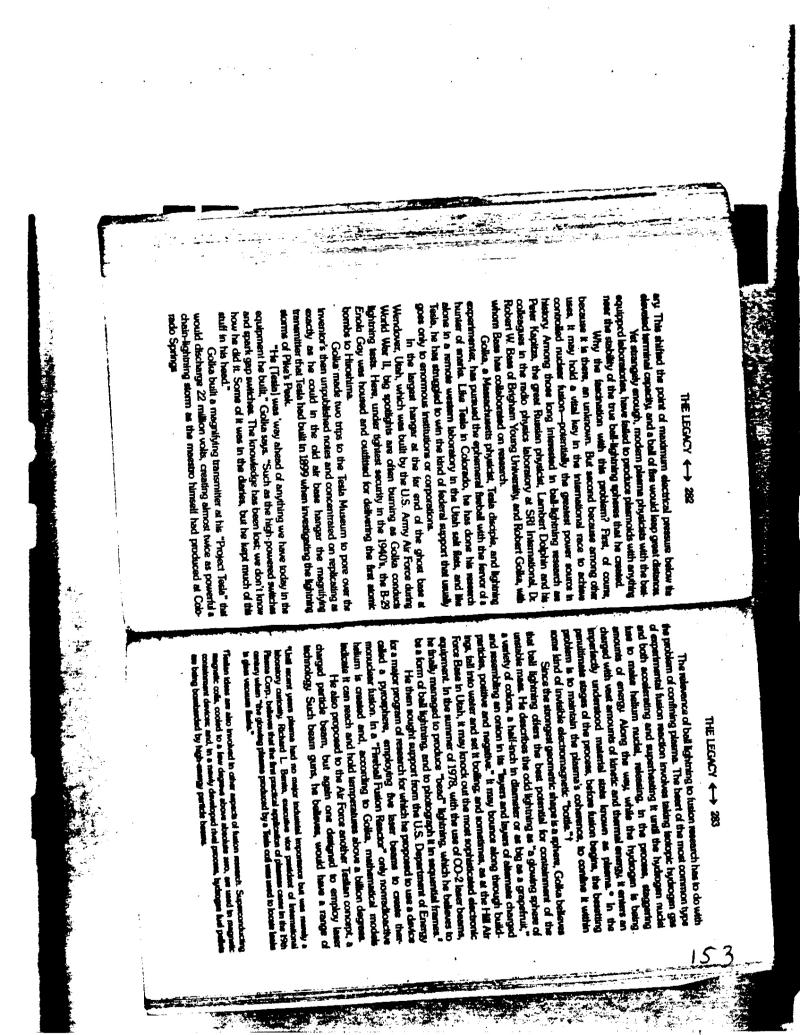
Nikola Tesla Documents
Nikola Tesla FBI Files - Page 153
THE LEGACY - 282 ary. This shifted the point of maximum electrical pressure below the elevated terminal capacity, and a ball of fire would leap great distances Yet strangely enough, modem plasma physicists with the bestequipped laboratories, have failed to produce plasmoids with anything near the stability of the true ball-lightning spheres that he created. course, Why the fascination with this problem? First, because it is there, an unknown. But second because among other uses, It may hold a vital key in the international race to achieve controlled nuclear fusion-potentially the greatest power source in history Among those long interested in ball-lightning research are Peter Kapitza, the great Russian physicist, Lambert Dolphin and his colleagues in the radio physics laboratory at SRI International, Dr. Robert W. Bass of Brigham Young University, and Robert Golka, walih whom Bass has collaborated on research. Golka, a Massachusetts physicist, Tesla disciple, and lightning experimenter, has pursued the ephemeral fiseball with the fervor of a hunter of snarks. Like Tesla in Colorado, he has done his research alone in a remote westem laboratory in the Utah salt flats, and like Tesla, he has struggled to win the kind of federal support that usually goes only to enormous institutions or corporations. in the largest hangar at the far end of the ghost base at Wendover, Utah, which was built by the U.S. Army Air Force during World War II, big spotlights are often burning as Golka conducts Nightning tests. Here, under tightest security in the 1940's, the B-29 Enola Gay was housed and outfitted for delivering the first atomic bombs to Hiroshima. Golka' made two trips to the Tesla Museum to pore over the Inventor's then unpublished notes and concentrated on replicating as exactly as he could in the old air base hangar the magnifying transmitter that Tesla had built in 1899 when investigating the lightning storms of Pike's Pook. "He (Tesia) was 'way ahead of anything we have today in the equipment be built," Golka says. "Such as the high-powered switches and spark gap switches. The knowledge has been lost, we don't know how he did it. Some of it was in the diaries, but he kept much of this stuff in his head." Golka built a magnifying transmitter at his "Project Tesla" that would discharge 22 million volts, creating almost twice as powerful a chain-lightning storm as the maestro himself had produced at Colorado Springs THE LEGACY → 283 The relevance of ball lightning to fusion research has to do with the problem of confining plasma. The heart of the most common type of experimental fusion reaction involves taking isotopic hydrogen gas and both accelerating and superheating it until the hydrogen nuclei fuse to make hellum nuclei, releasing, in the process, staggering amounts of energy Along the way, while the hydrogen is baing. charged with vast amounts of kinetic and thermal energy, it enters an imperfectly understood material stats known as plasma." In the penultimate stages of the process, before fusion begins, the besetting problem is to maintain the plasma's coherence, to confine it within some kind of invisible electromagnetic "bottle."† 153 Since the strongest geometric shape is a sphere, Golka believes that ball lightning offers the best potential for containment of the unstable mass. He describes the odd lightning as "a glowing sphere of a variety of colors, a half-inch in diameter or as big as a grapefruit,” and resembling an onion in its "layers and layers of alternate charged particles, positive and negative." It may bounce along through buildings, fall into water and set it boiling; and sometimes, as at the Hill Air Force Base in Utah, it may knock out the most sophisticated electronic equipment. In the summer of 1978, with the use of CO-2 laser beams, he finally managed to produce "bead" lightning, which he believes to be a form of ball lightning, and to photograph it in sequential frames.* He then sought support from the U.S. Department of Energy for a major program of research for which he proposed to use a device called a pyrosphere, employing five laser bears to create ther monuclear fusion. In a "Fireball Fusion Reactor" only nonradioactive helium is created and, according to Golka, mathematical models Indicate it can reach and hold temperatures above a billion degreas. He also proposed to the Air Force another Teskan concept, a charged particle beam, but again one designed to employ laser technology Such beam guns, he belleves, would have a range of "Unill recent years plasma had no major industrial importance but was reavaly a laboratory curiosity, Richard L. Barsin, executive vice president of International Phema Corp, believes that the first practical application of plasmas came in the 19th century when the glowing pleame produced by a Tesla coll was used to locate lanks glas vecum Basks.” fiestan idees are also involved in other aspects of fusion research. Superconducting magnetic colls, cooled to a low degreus above absolute asso, are used in magnetic containment devices; and, in a newly developed rival process, hychogen ludi pal a being bombarded by high-energy particle beams.
